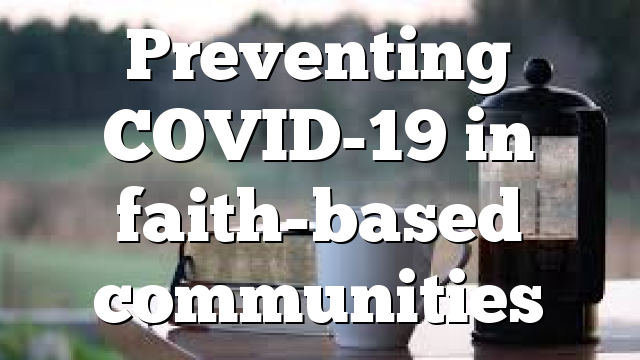Click to join the conversation with over 500,000 Pentecostal believers and scholars
Click to get our FREE MOBILE APP and stay connected
| PentecostalTheology.com



Here are the CDC’s recommendations for preventing COVID-19 in faith-based communities.
- First and foremost, if you do not feel well, please do not come to church. New research shows that COVID-19 can travel 4.5 meters (15 feet) by cough and stay suspended in the air for up to 30 minutes (source). The dry cough is the most common symptom of COVID-19 with fewer than half of the infected getting a fever or having trouble breathing. This means COVID-19 can feel like a very mild cold, and we have been conditioned to go about our normal routines when we have a very mild cold. It is common to have policies in church nurseries and children’s church that you should not bring your child to class if they have had a fever or vomited in the past 24 hours to prevent the spread of illness, but it is also common to guilt those who do not come to church with what we consider to be a mild illness. Until COVID-19 dies down, we have to take mild coughs very seriously because the death rate for those who catch COVID-19 is somewhere between 1% and 5% with many epidemiologists reporting that they believe it is 3.5%. Going to church if you have any symptoms of COVID-19 when the death rate is 3.5% is simply unacceptable. People need to understand that it is “okay” to miss church for two weeks if they show symptoms and that they are actually expected to stay home if they show even mild symptoms.
- Greet each other with a holy wave for the next couple of months. Holy kisses and the right hand of fellowship are currently unnecessary risks. The point of greeting through contact is to express love and unity, but spreading a life-threatening virus is not an act of either. The pastor must also follow this advice.
- Print these WHO instructions for how to properly wash hands and post them in all bathrooms.
- Provide hand sanitizer at doorways, and print and post this “how to rub hands for hand hygiene” poster near them.
- Request during the announcements of every service that congregants cover their coughs and sneezes and wash their hands with soap for at least 20 seconds each time they visit the restroom, and invite congregants to take advantage of the provided hand sanitizer.
- Encourage those who can to give electronically as banknotes are one of the ways this virus is circulating. For those who wish to give physically, do not pass plates. Instead, allow givers to bring the money to the plates at the altar or else place plates near the exits to give on the way out. Provide latex gloves for the ushers who will be handling the banknotes and checks.
- Either postpone communion or change communion distribution policies. If distributed by an usher (most common in the churches I have attended), the ushers must have washed their hands immediately prior to serving communion in accordance with the WHO document above. Ushers should serve the body by dropping it into the hand of the recipient who can be instructed to cup his hand to receive the body as many mainline churches do. The recipient should then receive an individual cup in his or her flat palm. The distributors should not touch the hand of the recipient. Any distributor who inadvertently touches the hand of a recipient should immediately stop distributing and allow the other ushers to complete the service. It may be wise to have “extra” ushers for if this happens.
- When giving an altar call, altar workers should find a place away from the face (including forehead) or upper arms of a person to lay on hands. Touching a person’s face can infect them with the virus or pick up the virus and transmit it to the next person who is prayed for. Many people are coughing and sneezing into their elbows or upper sleeves, so avoiding those areas will help keep the altar worker from becoming infected. When praying as an altar worker, point your face away from the person you are praying for so that you don’t aerosolize the virus into their face. It is preferable to point your mouth toward the ground during the laying on of hands.
- Sanitize all major “touchpoints” after each service. This includes all door handles, coffee bar tabletops, visitor center tabletops, soundboard knobs, piano keys, microphone surfaces, etc. Prop open doors when suitable so fewer people touch them in the first place. The length of time the virus survives on a surface depends on factors such as temperature and the type of surface—for example at around 98F, it can survive for two to three days on glass, fabric, metal, plastic or paper—so sanitizing after each service is a good idea.
- Use a system that allows fewer “switches” of microphones. For example, use color-coded microphone windscreens, electrical tape, or other markers to identify microphones and then ensure that each microphone is assigned to a single person between sanitizations.




Varnel Watson
some have tried by washing hand with holy water William DeArteaga has a great post about this on his blog
Jared Cheshire
Varnel Watson
Jared William DeArteaga https://www.businessinsider.com/coronavirus-people-are-selling-misleading-books-about-virus-on-amazon-2020-2
Varnel Watson
Does anyone know anyone that have coronavirus.
Anyone you work with? Has your doctors office been quarantine?
Schools have been shut down, concerts shut down, and even Some churches. NBA and flights suspended Now, if you hadn’t been suspicious of your media controlling by fear then you might should take a second look at it.